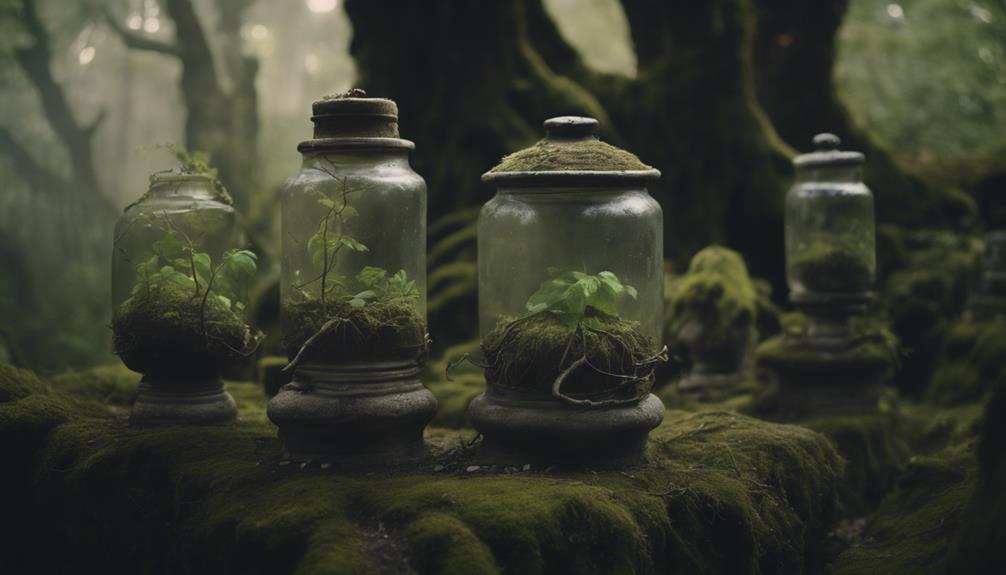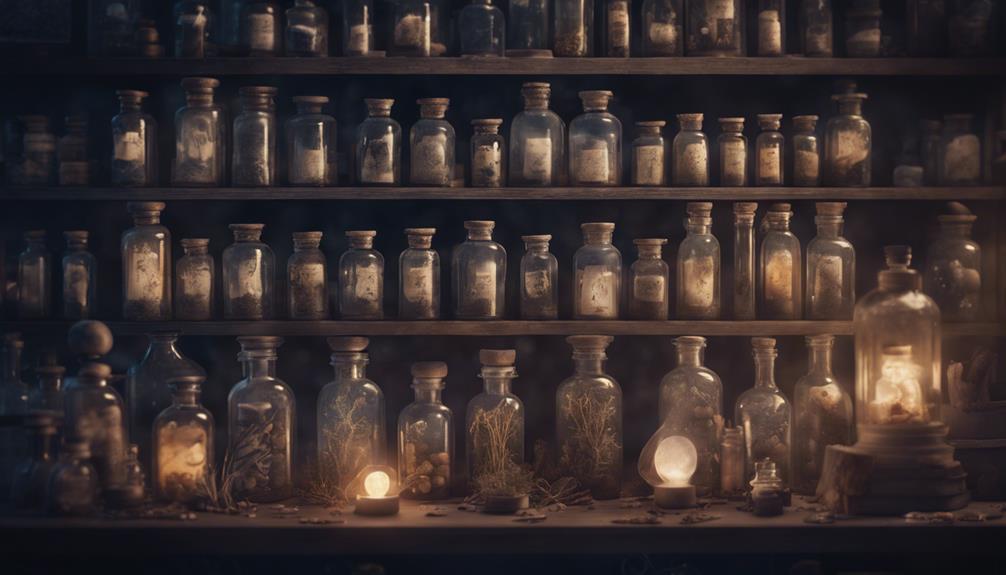We're starting on a journey to master herbalism from home, and it begins with seven essential steps. First, we'll establish the foundation by understanding plant identification, harvesting, and preparation techniques. Next, we'll construct a home apothecary, organizing essential herbs and supplies. We'll also explore herb-drug interactions and master herbal formulations. Developing a holistic practice, maneuvering legal and ethical issues, and pursuing a career in herbalism will follow. As we progress, we'll gain a deeper understanding of this complex field and uncover the intricacies of creating personalized holistic treatments. Further exploration will reveal the complexities of this multifaceted practice.
Key Takeaways
• Master herbalism by laying a strong foundation in plant identification, harvesting, and preparation techniques, as well as anatomy and physiology.
• Build a home apothecary by storing herbs properly, organizing essential supplies, and setting up an efficient workspace.
• Understand herb-drug interactions and potential risks when combining herbal remedies with medications, consulting healthcare providers as needed.
• Develop a holistic practice by recognizing the interconnectedness of physical, mental, emotional, and spiritual well-being, and providing individualized care.
• Pursue a career in herbalism by exploring various career paths, specializing in a specific area, and networking to build a client base.
Laying the Foundation of Herbalism
As we commence our herbalism journey, we must first establish a solid understanding of the fundamental principles that underpin this ancient practice. We're not just learning about herbal medicine; we're delving into a rich history and cultural significance that spans centuries.
To truly grasp the essence of herbalism, we need to understand the basics of plant identification, harvesting, and preparation techniques. This foundation is essential in creating effective herbal preparations that can be used to treat various health conditions.
We'll explore the therapeutic properties of common herbs, learning how they interact with the body and understanding their applications in different health scenarios. By developing a solid foundation in anatomy, physiology, and herbal pharmacology, we'll gain a deeper appreciation for the intricate relationships between herbs and the human body.
Through hands-on exercises, we'll gain practical experience in making herbal preparations and creating personalized remedies. By laying a strong foundation in herbalism, we'll set ourselves up for success in our journey to master this ancient practice.
Building a Home Apothecary

As we embark on building our home apothecary, we'll need to contemplate how we'll store our herbal remedies, organize the essentials, and set up our space for maximum efficiency.
We'll explore the must-haves for our apothecary, from jars and labels to measuring equipment and reference books.
Herbal Remedies Storage
We begin constructing our home apothecary by ensuring the proper storage of our herbal remedies, which is essential to maintaining their potency and effectiveness. To achieve this, we store our dried herbs in airtight containers away from light, heat, and moisture. We label each jar with the herb name, date of purchase or harvest, and any specific uses or precautions.
Fresh herbs, on the other hand, are kept in the refrigerator wrapped in a damp paper towel or placed in a glass of water to prolong their freshness. When it comes to our herbal tinctures and oils, we store them in dark glass bottles to protect them from light degradation. We also make it a habit to rotate our herbs regularly to ensure freshness and potency in our home apothecary.
Organizing Apothecary Essentials
With our herbal remedies safely stored, we turn our attention to organizing the apothecary essentials that will help us efficiently prepare and use our herbal remedies. A well-organized home apothecary is vital for storing and accessing our herbal supplies, including herbs, tinctures, essential oils, and other materials.
To achieve this, we consider investing in glass jars, labels, measuring tools, and storage containers that will keep our apothecary tidy and functional. We utilize shelves, drawers, or cabinets to create a designated space for our herbal supplies, ensuring easy access and efficient workflow.
Proper labeling of herbs and herbal preparations is essential to avoid confusion and maintain safety in our home apothecary. By regularly inventorying and restocking our apothecary, we maintain a sufficient supply of herbs and materials for our herbal practice.
With a well-organized apothecary, we can focus on preparing and using our herbal remedies with confidence and precision.
Apothecary Setup Essentials
Let's start building our home apothecary by gathering the essential items that will form its foundation.
We'll need glass jars to store our herbal products, measuring spoons for accurate measurements, a mortar and pestle for grinding and mixing, and labels for organization.
Investing in high-quality dried herbs, carrier oils, beeswax, and essential oils will allow us to create a variety of herbal remedies.
To expand our apothecary tools, we can consider adding a scale, herb books, a dehydrator, and a double boiler.
It's important to store our herbs away from sunlight and moisture to maintain their potency and quality.
We should label each jar with the herb name, date of purchase or harvest, and any specific usage instructions for easy identification.
By setting up our apothecary with these essential items, we'll be well on our way to creating a functional and efficient space for crafting our own herbal products.
A well-organized apothecary setup will help us stay focused on creating high-quality herbal remedies.
Understanding Herb-Drug Interactions

As we explore the world of herbalism, it's crucial that we grasp the critical concept of understanding herb-drug interactions.
We'll examine how herbal remedies can impact the efficacy of medications, and vice versa, discussing the interaction risks and warnings associated with combining the two.
Herbal Remedies and Medications
We must consider the critical issue of herb-drug interactions, which can greatly impact the safety and efficacy of treatment plans when combining herbal remedies with prescription medications. As herbalists, we need to understand that herbal remedies can interact with medications, affecting their potency or causing adverse effects.
Factors influencing herb-drug interactions include the type of herb and medication, dosage, frequency of use, and individual differences in metabolism.
Many common herbs like St. John's Wort, garlic, and ginkgo can interact with prescription medications.
Understanding herb-drug interactions is essential for herbalists and healthcare professionals to ensure safe and effective treatment plans for patients.
Consultation with a healthcare provider knowledgeable in herb-drug interactions is recommended before combining herbal remedies with medications to prevent potential complications.
Herb-drug interactions can occur when herbal remedies and medications interact in the body, affecting the effectiveness or safety of either.
Interaction Risks and Warnings
When combining herbal remedies with prescription medications, we must be aware of the potential interaction risks and warnings that can impact our health. As we explore the world of herbalism, it's important to understand that herb-drug interactions can greatly affect the effectiveness and safety of both herbs and medications.
Some herbs can inhibit or enhance the effects of certain medications, leading to potential health risks. For instance, St. John's Wort, a popular herbal remedy for depression, can reduce the effectiveness of certain medications, such as blood thinners and antidepressants.
To guarantee safe and effective herbal use, it's essential to consult with a healthcare professional or herbal practitioner before combining herbs with prescribed medications. Factors like dosage, frequency, and individual health conditions can influence herb-drug interactions, making it necessary to have a thorough understanding of potential interactions.
Pharmacokinetic and Pharmacodynamic
When exploring herb-drug interactions, it's crucial to delve into the areas of pharmacokinetics and pharmacodynamics. As students of herbalism, understanding how these two fields impact herb-drug interactions is vital.
Pharmacokinetic focuses on how the body processes drugs and herbs, including absorption, distribution, metabolism, and excretion. Conversely, pharmacodynamic examines how drugs and herbs interact with the body to produce therapeutic effects.
To gain a better understanding of herb-drug interactions, we must take into account the following factors:
- Dosage and timing of administration can impact herb-drug interactions
- Individual health conditions, such as kidney or liver disease, can modify herb-drug interactions
- Certain herbs can inhibit or induce enzymes that metabolize drugs
- Some drugs can enhance or diminish the effects of herbs
- Age, diet, and lifestyle can influence herb-drug interactions
Mastering Herbal Formulations
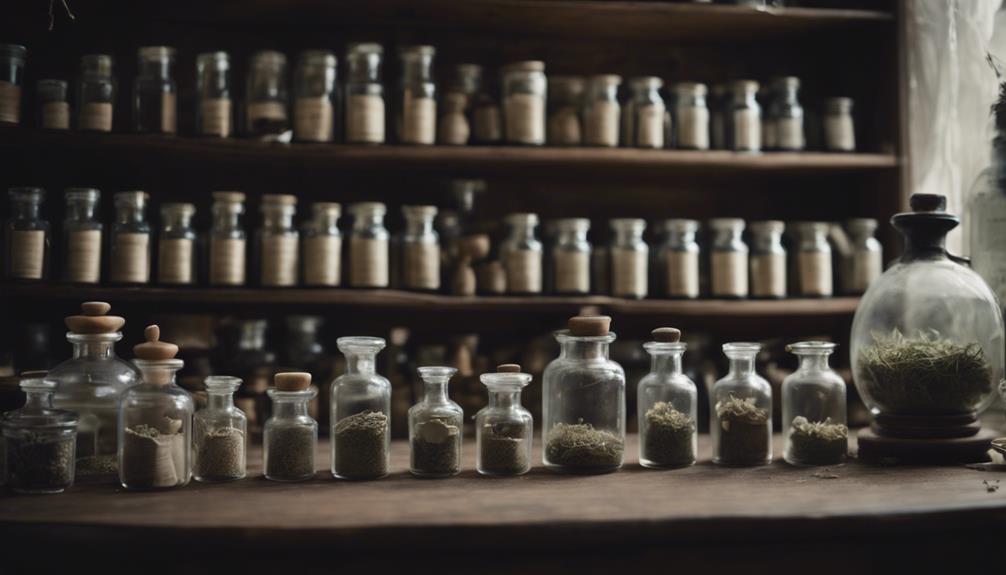
By understanding the intricacies of individual herbs and their synergistic relationships, we can reveal the art of creating effective and safe herbal formulations that cater to unique needs and health conditions. As Master Herbalists, we learn to craft custom blends that balance energetics, tastes, and therapeutic actions. This mastery involves knowledge of synergistic herb combinations, allowing us to create formulations that are greater than the sum of their parts.
| Herbal Formulation Considerations | Key Factors |
|---|---|
| Energetics | Cooling, warming, or neutral |
| Tastes | Sweet, sour, salty, bitter, pungent, astringent |
| Therapeutic Actions | Adaptogenic, anti-inflammatory, antimicrobial |
Advanced courses in Master Herbalism explore topics like herb-drug-nutrient interactions, traditional Chinese medicine, and Ayurvedic medicine. These studies enhance our formulation skills, enabling us to create targeted blends that address specific health concerns. By mastering herbal formulations, we can investigate the full potential of herbal remedies and provide personalized support for our clients.
Developing a Holistic Practice

As we venture into the domain of Master Herbalism, we recognize that developing a holistic practice requires a multifaceted approach that honors the intricate connections between physical, mental, emotional, and spiritual well-being. This integrated approach is essential for creating a thorough herbal practice that truly supports our clients' overall health.
To achieve this, we must focus on individualized care, understanding each client's unique needs, preferences, and health history. Our herbal practice should incorporate a variety of remedies, dietary recommendations, lifestyle changes, and mind-body practices to support overall wellness. By emphasizing prevention and education, we empower our clients to take an active role in their health and well-being. Additionally, we should collaborate with other healthcare providers to offer thorough and integrated care for our clients.
Here are the key elements of a holistic herbal practice:
- Consider physical, mental, emotional, and spiritual aspects of health
- Provide individualized care based on each client's unique needs and health history
- Utilize a range of herbal remedies, dietary recommendations, and lifestyle changes
- Emphasize prevention and education to empower clients
- Collaborate with other healthcare providers for thorough care
Navigating Legal and Ethical Issues
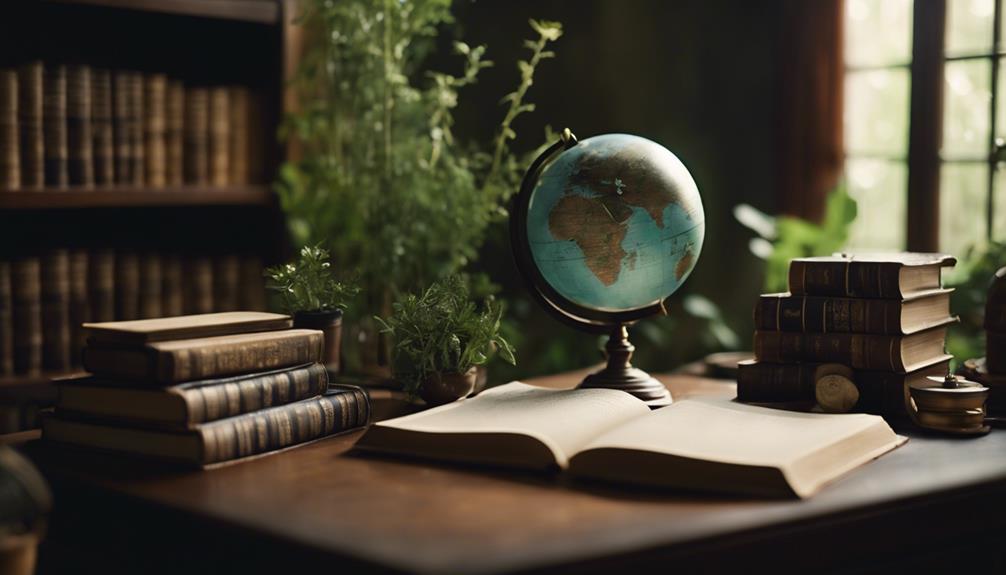
We must ensure that our holistic practice is grounded in a thorough understanding of the legal and ethical frameworks that govern our profession. As herbalists, we must adhere to legal regulations and ethical guidelines to avoid legal issues and maintain a professional reputation.
Understanding the scope of practice is essential for us to operate within legal boundaries, ensuring we don't overstep our authority. We should also invest in reputable training programs that provide us with the necessary certifications and credentials to practice ethically.
During consultations, we must obtain informed consent from our clients, ensuring they're aware of the benefits and risks associated with herbal remedies. Staying updated on industry standards and regulations is vital to maintaining ethical practices.
Pursuing a Career in Herbalism
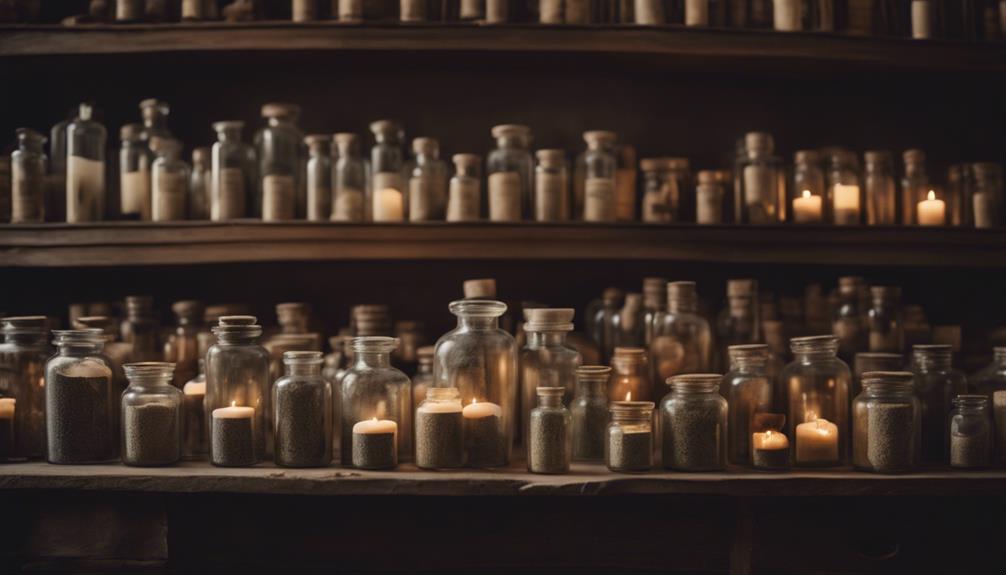
With a solid foundation in herbalism, we can now explore the various career paths and opportunities that await us in this rewarding field. As we investigate the world of herbalism, we're met with a multitude of possibilities. From working in wellness centers, clinics, or private practice, to teaching, herbal counseling, or owning an herb business, the options are vast.
Some of us may choose to specialize in specific herbal therapies, such as Traditional Chinese Medicine, to enhance our career prospects and attract more clients. Others may opt to collaborate with health care professionals or develop herbal products for retail. The key to success lies in networking, building a client base, and choosing a specialty based on interest and demand.
Here are just a few examples of the many career paths available to us:
- Naturopathic physician
- Clinical herbalist
- Herbal product maker
- Retailing herbal products
- Teaching herbalism
Frequently Asked Questions
How Long Does It Take to Become a Master Herbalist?
We often wonder how long it takes to become a Master Herbalist. The answer varies, as programs differ in length and structure.
Typically, it can take 1-3 years to complete an advanced herbalism program, depending on the curriculum, course load, and our individual study pace. Factors like program requirements, practical training, and assessments also influence the duration.
How to Learn Herbalism on Your Own?
We're keen to learn herbalism on our own, and it's definitely possible.
We can start by utilizing online resources, such as courses and tutorials, to gain a thorough understanding of herbalism.
We can also join online communities and forums to connect with like-minded individuals who share our passion for herbalism.
Additionally, building a personal library with recommended books and resources will provide us with in-depth knowledge and reference materials.
What Education Does a Master Herbalist Need?
When we think of master herbalists, we imagine experts with a thorough understanding of phytotherapy and holistic health perspectives.
To become one, we need advanced training in programs that cover TCM, Ayurvedic medicine, and Western energetics.
A master herbalist's education focuses on health topics, disease management, and client support, preparing them for diverse roles in the herbal industry.
This extensive education equips individuals with the skills and knowledge to excel in their careers.
Where Do Herbalists Make the Most Money?
We've found that herbalists can earn the most in private practice, with average annual salaries ranging from $50,000 to $80,000, depending on location and client base.
Those specializing in fields like naturopathic medicine or clinical herbalism tend to have higher earning potential due to their advanced expertise.
Additionally, herbal product makers can generate substantial income through sales and distribution, although success varies depending on business performance.
Conclusion
As we commence on this journey to master herbalism from the comfort of our own homes, we've woven together a tapestry of knowledge, from laying the foundation of herbalism to navigating legal and ethical issues.
Like a skilled apothecary, we've carefully blended theory and practice, ensuring a holistic approach that honors the ancient art of herbalism.
Now, as we step into the world of herbalism, we're equipped to heal, to nurture, and to inspire – our own health, our communities, and the world at large.


